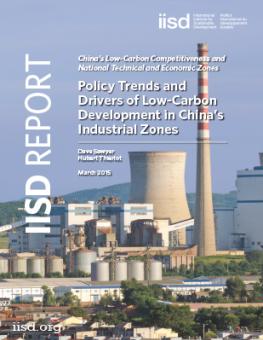
Policy Trends and Drivers of Low-Carbon Development in China’s Industrial Zones
With China’s 2009 Copenhagen Accord commitment to reduce the greenhouse gas intensity of its economy by 40–45 per cent by 2020, the government has moved on regulations and incentives to improve energy efficiency and increase the mix of low greenhouse gas-emitting energy sources in the economy.
Another key driver, of course, is the poor air quality that is systemic in so many of China’s large cities. Also adding to the drive to decarbonize and improve air quality is energy security, which is both an issue outside of China’s borders and also an interprovincial issue. Some provinces with a heavy reliance on domestic coal are seeking to generate more non-emitting electricity at home, while simultaneously supporting innovation and technology development.
We can see, therefore, a whole host of nationally driven policies and programs that are beginning to cascade down to the provinces, municipalities and industrial zones. But we also see a more distributed effort to develop policy from the bottom up. This is, of course, supported by central guidance at the national level that sets overarching performance targets, which are then allocated out of the provincial and municipal levels. Local regulatory authorities are responsible for policy design to achieve their targets, following central guidance.
As the provinces, municipalities and industrial zones start to design and implement the policies, we can expect that they will take into account local circumstances. This jurisdictionally distributed policy setting has the impact of catalyzing a dynamic policy-learning process both within and outside of government. But, of course, there are headwinds. Notably, such a disparate system of policies and programs, with limited central guidance on implementation detail, is leading to an overlapping and complex set of policies that industry must sort out.
Such complexities are leading to industry uncertainty about what is required and how best to respond. Not only is it difficult for industry to understand and interact with this growing dynamic ecosystem of policies and programs, but there is also a risk of high regulatory costs associated with multiple transactions for compliance. Policy complexity can also lead to inefficiencies, with the regulated entities perhaps not entirely understanding what is required of them for compliance, leading to decisions that can hamper competiveness. At the very least, uncertainty in the policy environment will lead to inaction and deferred decisions with respect to major capital investments that could improve energy and greenhouse gas emissions performance in time. At worst, it could lead to high-emitting capital lock-in, where technology choices now lock-in high-emitting industrial processes that are more expensive to transition to low-carbon alternatives in the future.
It is in this dynamic environment that IISD is conducting original research that looks for emerging energy and greenhouse gas emission policy trends that affect business at the national, provincial, municipal and zone levels. A secondary objective is to help policy-makers better coordinate their energy and greenhouse gas policies and to learn how industry may respond to those policies.
In this paper, we provide a synthesis of over 100 policies and programs targeted at industry and identify trends in policy design that are likely to be key determinants of the policy impact on industry. While not an exhaustive review of all low-carbon and energy policies in China, with literally hundreds of policies emerging at the provincial and municipal levels, we do nevertheless provide a good overview on the emerging policy environment focusing on how central-level guidance is cascading down to industry.
Additional downloads
You might also be interested in
Heatwaves to hit China once every 5 years as global extreme weather events multiply, study finds
Record-breaking heatwaves that have scorched North America, Europe and China are set to worsen in future unless the world stops burning fossil fuels, according to a study by the World Weather Attribution (WWA) academic initiative.
Transition from fossil fuels to renewable energy can pose fiscal challenges for India: study
The global transition away from fossil fuels to renewable energy sources could trigger financial challenges for India and major developing countries such as Russia, Brazil and China because of their high dependence on revenues from fossil fuel, according to a study by the International Institute for Sustainable Development (IISD).
IISD Report: Shifting Away from Fossil Fuels Could Lower BRIICS Nations' Revenues
A new report by the International Institute for Sustainable Development (IISD), titled Boom and Bust: The Fiscal Implications of Fossil Fuel Phase-Out in Six Large Emerging Economies, looks at the potential financial ramifications of phasing out fossil fuels in six emerging economies — Brazil, Russia, India, Indonesia, China, and South Africa (BRIICS). They must begin adjusting their fiscal policies to account for declining fossil fuel use or risk a $278 billion revenue gap by 2030.
India, 5 others face fall in fossil fuel revenues
As the global clean energy transition gathers pace, six emerging economies need to start adjusting their fiscal policies now to account for declining fossil fuel use-or risk a $278 billion gap in revenues by 2030, equivalent to the combined total government revenues of Indonesia and S. Africa in 2019, according to a new report by the International Institute for Sustainable Development.